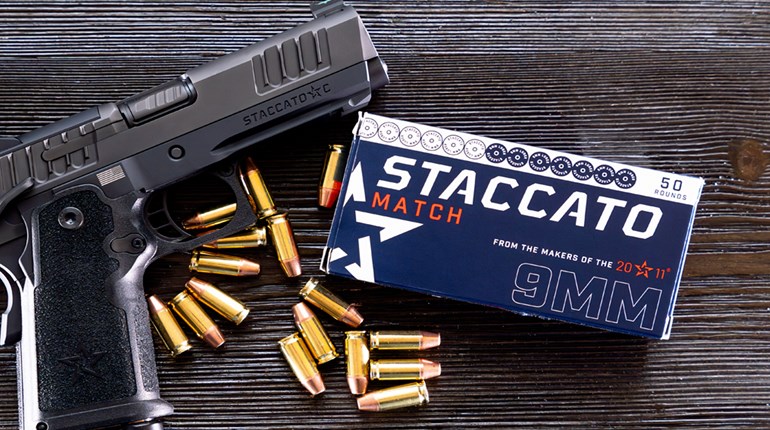
Muzzle velocity is dependent on several things; barrel length is just one contributing factor.
There’s lots of discussion about how barrel length can affect velocity. It can be important, particularly with defensive-handgun cartridges, because you need enough velocity to make the bullet expand. Moreover, velocity has an impact on wounding potential. The problem with blanket estimations is that they are only that—estimates. If you base your beliefs on estimates or guesses, you could be considered delusional.
They main problem with the blanket estimate is that some guns generate higher or lower muzzle velocities than anticipated. This is due to variations in actual bore—groove-to-groove and land-to-land—dimensions. Chamber dimensions also vary and can impact pressure, which translates to velocity. To say a particular load will generate a certain velocity from a specific barrel length—based on what it generated in another barrel length—is nothing but a guess. A chronograph is the only way to know for sure.
Still, we make assumptions on how barrel length impacts velocity, and we do this based on established averages. Tests to support these conclusions are often conducted by using one load, and cutting a barrel off—1 inch at a time—and then measuring the velocity at each length. I’m not much for cutting guns into pieces, but fortunately I had some data from a previous test that might shed some light on how much guessing we’ve been doing.
I’d previously tested eight .32 H&R Mag. and nine .327 Fed. Mag. factory loads in four different firearms. I used a Ruger SP101, Ruger Single Seven, Ruger Blackhawk and a custom Marlin 1894, with barrel lengths ranging from 3 to 16 inches. I found the results rather fascinating, and they should be of particular interest to shooters who might be struggling with what barrel length they think they need for a defensive handgun, or who might be wondering how much velocity they might gain from a pistol-caliber carbine.
Barrel Length: 3 to 4.6 Inches
Comparing 17 loads, out of two revolvers, with 3- and 4.6-inch barrels, I found that seven of the loads produced a lower velocity from the longer barrel. The average increase in velocity from the 4.6-inch barrel was only 12.47 fps or 1.03 percent. This is abnormal, but it illustrates how different guns can produce radically different velocities. It’s usually due to the variances mentioned. What might seem like a microscopic difference can drastically influence a firearm’s performance.
The learning point is that, just because you choose a handgun with a barrel 1.5 inches longer than another, does not mean the handgun with the longer barrel will generate higher velocities. This is one of the problems with basing velocity estimates on the barrel-cutting exercise. In that experiment you are essentially assuming all firearms with the same length barrel will generate roughly the same velocities. The problem is, they don’t.
Barrel Length: 3 to 4.6 Inches
Comparing the 3-inch-barreled SP101 to the 5.5-inch-barreled Blackhawk produced much more-consistent results. Here we saw an average velocity gain of 142.2 fps, an average increase of 56.88 fps per every 1 inch of barrel. But here again, we’re making a broad estimate. The 130-grain .327 Fed. Mag. Buffalo Bore hardcast load only showed a gain of 39 fps from the 5.5-inch barrel, while the DoubleTap 115-grain hardcast load showed an increase of 414 fps.
Why the tremendous discrepancy? Gunpowder, mostly. Some powders burn quite fast and reach peak pressure—peak velocity—very soon. Others take more time. The bullet fired from the DoubleTap load needed more time in the barrel for peak pressure to be reached. The lesson learned here is every load is different. Just because one shows a minimal increase in velocity due to an increase in barrel length, does not mean all others or another will show the same.
Barrel Length: 3 to 4.6 Inches
This is representative of comparing a snubnose revolver or ultra-compact semi-auto to a pistol-caliber carbine, the latter of which does not get as much respect as they deserve. This is partly because they fire pistol cartridges, and partly because they’re often compared to carbines that shoot rifle cartridges such as the 5.56 NATO. On average, the velocity increase from a 3- to 16-inch barrel was 487.7 fps, which works out to 37.51 fps per every 1 inch of barrel. That sounds reasonable and closer to the assumed, but mostly mythical, 25 fps per-inch of barrel most shooters expect to see.
But here again, that’s not a reasonable depiction of the difference. For example, Federal’s 85-grain .327 Fed. Mag. JSP load only generated 1,340 fps from the 3-inch barrel, but blistered out of the 16-inch barrel at an impressive 2,155 fps. That’s a 60.82 percent gain in velocity, and a difference of 815 fps, or 62.69-fps-per-inch of barrel. On the other hand, Hornady’s 80-grain .32 H&R Mag. FTX load only showed an increase of 262 fps—20.15 fps per every 1 inch of barrel, which is quite a bit below the 487 fps average, and a mere 25.22 percent increase.
Regardless of the individual variances from load to load, what we see here is that when pistol cartridges are fired from carbines, you can expect a substantial increase in velocity. If the bullet is robust enough to handle the higher impact velocity, you can expect deeper penetration and enhanced wounding. If it’s not, the wound cavity will be shallow, but wickedly nasty due to the collapse of the bullet.
The Takeaway
The main takeaway from all of this data is that you cannot use some arbitrary experiment or number to make a blanket prediction about barrel length and velocity. Every load is different and every gun is, too. Some loads need more barrel to deliver maximum performance, and some guns—due to dimensional variations—will produce lower or higher than expected velocities.






































